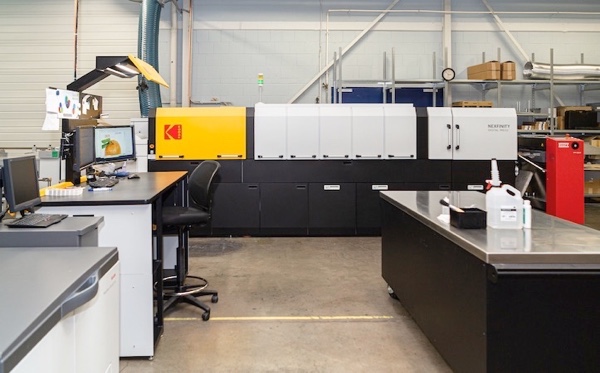Inkjet & Digital Printing
Eckenfelder goes digital with a KODAK NEXFINITY Press

Monday 27. January 2020 - When the end of the year is fast approaching and millions of new calendars are purchased, given as a gift and hung on the wall, be it by businesses or private individuals, the critical production phase has already been over at Eckenfelder GmbH & Co. KG for several weeks. This family owned firm in Hörselberg-Hainich - in the geographical center of Germany - employs 52 people dedicated to the development and end-to-end production of wall and desk calendars and notebooks.
From photography, design and layout through printing to finishing, all essential steps take place under one roof. The Eckenfelder portfolio comprises around 170 different calendar products in numerous shapes and sizes as well as about 100 types of notebook with a very wide choice of colors, cover materials and enhancement options. These products are sold through promotional item and stationery wholesalers to customers in industry, commerce and the service sector.
Digital transformation in calendar printing
Up until May 2019, Eckenfelder printed all such “companions through the year” in offset. In the meantime, offset has been complemented with, and partially substituted by, a KODAK NEXFINITY Digital Press. “The NEXFINITY Press was the solution we came up with for handling most of our short-run production in digital,” says Managing Director Daniel Eckenfelder, who heads the firm together with his brother Christof. “We have a lot of runs totaling less than a thousand because of the promotional imprints we do for businesses. The formats are typically up to a meter long, with materials between 0.5 and 0.6 mm thick. Thats traditionally a difficult combination for digital presses to deal with. On the other hand, its a segment that also creates problems of an economic and technical nature for offset equipment, and the sustainability credentials are dubious because theres a relatively large amount of waste.” Responding to these requirements, Eckenfelders KODAK NEXFINITY Press is equipped with a BDT long sheet feeder and a long sheet delivery.
The fact that the press is suitable for a wide range of substrates, including recycled materials, likewise fits in with the companys production needs. The press ships with the Substrate Expansion Kit as standard, thus meeting a key condition for printing on the thicker types of board that are the norm with calendars. “Whats more, the straight passage of the sheets through the NEXFINITY Press is an advantage with substrates that are not amenable to bending. And weve even printed on synthetic and compound materials without any problem,” Eckenfelder explains.
It was also important to him that the NEXFINITY Press is based on a sturdy frame structure with a robust paper feed unit for high-volume production. He formulates one of the central objectives behind the investment in digital production printing as follows: “We want to be capable of producing everything in digital, with no technical restrictions to constrain us. With the NEXFINITY Press, practically anything goes and its an exceptionally smooth-running press. We were looking for something that is suitable for industrial use and can take the place of offset.” The latter is clearly the case: since the digital press from Kodak went into operation, the company has phased out two sheetfed offset presses in 50 x 70 cm format. An eight-color press in 70 x 100 cm format is now the last remaining representative of offset printing at Eckenfelder.
Fifth Imaging Unit: A whole universe of possibilities
The NEXFINITYs Fifth Imaging Unit plays a crucial role in the calendar makers production process. Alongside the standard Light Black HD Dry Ink, Eckenfelder uses red, green and blue as additional colors for expanding the color gamut, Dimensional Clear Dry Ink for tactile dimensional printing and Clear Dry Ink to give a fully or partially transparent topcoat. Since the company also owns a KODAK Glossing Unit, prints enhanced with Clear Dry Ink can be coated with a gloss finish similar to UV varnish.
Particularly with photo calendars, which show the year at its most attractive, the printer takes liberal advantage of the RGB color gamut expansion options. “The NEXFINITY already has a very good CMYK color gamut per se. By using red, green or blue as additional colors in the Fifth Printing Unit, we can go a long way towards emulating Pantone or HKS colors,” the Managing Director continues. “Moreover, in conjunction with our in-house color management system, the RGB color gamut expansion lets us explicitly emphasize the interaction of materials and pictures. Where color consistency is concerned, thats quite significant because we sometimes use very specific substrates for our calendars and we often combine different materials, which vary in terms of printability and color reproduction, in one and the same product.”
Sights set on further volume growth
The NEXFINITY Press at Eckenfelder churned out 500,000 A4 pages a month on average during the first six months. There are plans to increase its capacity from one shift daily to a minimum of two in 2020. As four people have been trained to operate and maintain it, the necessary human resources are already available. The extra “feed” will come first from print services unrelated to calendars, such as brochure and label production. Second, the general trend in the calendar business towards smaller-scale and increasingly personalized runs, coupled with the ability to streamline postpress workflows right through to picking and mailing simply by printing meta job information, plays into digitals hands – to the detriment of classic offset.
“The NEXFINITY Press lives up to our expectations. It performs in practice exactly as Kodak demonstrated to us upfront of our investment. The net production output is achieved and the quality is absolutely convincing,” Eckenfelder concludes.

